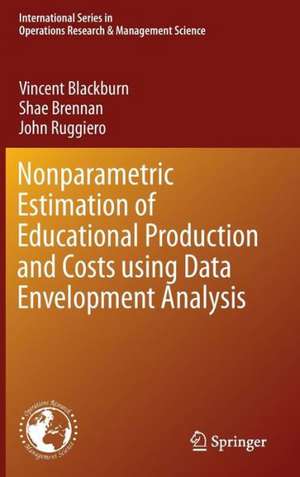Nonparametric Estimation of Educational Production and Costs using Data Envelopment Analysis: International Series in Operations Research & Management Science, cartea 214
Autor Vincent Blackburn, Shae Brennan, John Ruggieroen Limba Engleză Hardback – 8 iun 2014
The purpose of the book is to provide a comprehensive analysis of educational production using numerous public sector DEA models. We provide a review of DEA with SAS programming code to estimate technical, scale and allocative efficiency in chapter 2. In chapter 3, we extend the DEA models to control for exogenous factors of production. SAS code is also provided to estimate all public sector models. We use simulated data to illustrate the results. Chapters 4–6 provide a complete analysis of the primary and secondary schools. We analyze input and output oriented models and derive measures of technical, allocative and scale efficiency. We also provide estimates of environmental costs that arise from schools facing different operating environments based on socioeconomic conditions. In addition, we show how DEA can provide insight on adequacy—the minimum cost of providing a pre-defined adequate education. The models presented are consistent with public sector production in general and educational production in particular. We also provide a complete analysis of educational productivity for both primary and secondary schools using state of the art public sector Malmquistmeasures. The authors use current data on Australian schools to highlight important policy questions related to efficiency and productivity given concerns that schools are not allocatively scarce resources in an economic efficient way.
This research focus comes at an important watershed moment in the Australian Federal Governments’ current involvement in designing new nationally consistent funding models for both government and non-government schooling sectors with effect from 2014. A new National School Resourcing Standard is proposed to be implemented signaling a move to resource adequacy, school efficiency and value for money dimensions. These standards are consistent with the measures presented and estimated in this book. As a result, the models implemented in this book can serve as the basis to evaluate the funding changes associated with the transition from a ‘centralized’ to a new ‘decentralized’ set of school funding arrangements.
| Toate formatele și edițiile | Preț | Express |
|---|---|---|
| Paperback (1) | 355.30 lei 38-44 zile | |
| Springer Us – 3 sep 2016 | 355.30 lei 38-44 zile | |
| Hardback (1) | 387.75 lei 43-57 zile | |
| Springer Us – 8 iun 2014 | 387.75 lei 43-57 zile |
Din seria International Series in Operations Research & Management Science
- 20%
 Preț: 331.25 lei
Preț: 331.25 lei - 20%
 Preț: 570.61 lei
Preț: 570.61 lei - 18%
 Preț: 1132.02 lei
Preț: 1132.02 lei - 18%
 Preț: 773.72 lei
Preț: 773.72 lei -
 Preț: 170.39 lei
Preț: 170.39 lei - 17%
 Preț: 459.34 lei
Preț: 459.34 lei - 17%
 Preț: 360.47 lei
Preț: 360.47 lei -
 Preț: 263.40 lei
Preț: 263.40 lei - 24%
 Preț: 905.30 lei
Preț: 905.30 lei - 17%
 Preț: 460.08 lei
Preț: 460.08 lei - 17%
 Preț: 459.34 lei
Preț: 459.34 lei - 20%
 Preț: 631.58 lei
Preț: 631.58 lei - 13%
 Preț: 448.62 lei
Preț: 448.62 lei - 18%
 Preț: 738.28 lei
Preț: 738.28 lei - 18%
 Preț: 1225.94 lei
Preț: 1225.94 lei - 18%
 Preț: 948.92 lei
Preț: 948.92 lei - 18%
 Preț: 703.88 lei
Preț: 703.88 lei - 18%
 Preț: 957.44 lei
Preț: 957.44 lei - 15%
 Preț: 651.84 lei
Preț: 651.84 lei - 20%
 Preț: 336.21 lei
Preț: 336.21 lei - 15%
 Preț: 641.03 lei
Preț: 641.03 lei -
 Preț: 404.29 lei
Preț: 404.29 lei - 18%
 Preț: 950.21 lei
Preț: 950.21 lei - 15%
 Preț: 649.06 lei
Preț: 649.06 lei - 18%
 Preț: 725.75 lei
Preț: 725.75 lei -
 Preț: 394.12 lei
Preț: 394.12 lei - 18%
 Preț: 951.47 lei
Preț: 951.47 lei - 15%
 Preț: 639.59 lei
Preț: 639.59 lei - 18%
 Preț: 773.06 lei
Preț: 773.06 lei - 18%
 Preț: 889.29 lei
Preț: 889.29 lei - 15%
 Preț: 655.60 lei
Preț: 655.60 lei - 15%
 Preț: 640.06 lei
Preț: 640.06 lei - 15%
 Preț: 583.93 lei
Preț: 583.93 lei
Preț: 387.75 lei
Nou
Puncte Express: 582
Preț estimativ în valută:
74.20€ • 77.03$ • 61.87£
74.20€ • 77.03$ • 61.87£
Carte tipărită la comandă
Livrare economică 24 martie-07 aprilie
Preluare comenzi: 021 569.72.76
Specificații
ISBN-13: 9781489974686
ISBN-10: 1489974687
Pagini: 164
Ilustrații: X, 152 p. 34 illus., 10 illus. in color.
Dimensiuni: 155 x 235 x 15 mm
Greutate: 0.41 kg
Ediția:2014
Editura: Springer Us
Colecția Springer
Seria International Series in Operations Research & Management Science
Locul publicării:New York, NY, United States
ISBN-10: 1489974687
Pagini: 164
Ilustrații: X, 152 p. 34 illus., 10 illus. in color.
Dimensiuni: 155 x 235 x 15 mm
Greutate: 0.41 kg
Ediția:2014
Editura: Springer Us
Colecția Springer
Seria International Series in Operations Research & Management Science
Locul publicării:New York, NY, United States
Public țintă
ResearchCuprins
Introduction.- Data Envelopment Analysis.- DEA in the Public Sector.- Input-Oriented Efficiency Measures in Australian Schools.- Output-Oriented Efficiency Measures in Australian School.- Productivity Measurement.
Textul de pe ultima copertă
This book provides a complete analysis of educational production and costs using the nonparametric technique known as Data Envelopment Analysis (DEA). The book focuses on estimation of technical, allocative and scale efficiency in the public sector characterized by the influence of exogenous socio-economic variables. State of the art DEA models will be presented and fully discussed. Specific education topics important to policy makers including adequacy, technical, allocative and scale efficiency, productivity and environmental costs will be analyzed. To illustrate how these techniques can be applied to school systems worldwide, the authors use data on Australian elementary and high schools to develop nonparametric measures that will help inform current policy debate in Australia.
The purpose of the book is to provide a comprehensive analysis of educational production using numerous public sector DEA models. We provide a review of DEA with SAS programming code to estimate technical, scale and allocative efficiency in chapter 2. In chapter 3, we extend the DEA models to control for exogenous factors of production. SAS code is also provided to estimate all public sector models. We use simulated data to illustrate the results. Chapters 4–6 provide a complete analysis of the primary and secondary schools. We analyze input and output oriented models and derive measures of technical, allocative and scale efficiency. We also provide estimates of environmental costs that arise from schools facing different operating environments based on socioeconomic conditions. In addition, we show how DEA can provide insight on adequacy—the minimum cost of providing a pre-defined adequate education. The models presented are consistent with public sector production in general and educational production in particular. We also provide a complete analysis of educational productivity for both primary and secondary schools using state of the art public sector Malmquistmeasures. The authors use current data on Australian schools to highlight important policy questions related to efficiency and productivity given concerns that schools are not allocatively scarce resources in an economic efficient way.
This research focus comes at an important watershed moment in the Australian Federal Governments’ current involvement in designing new nationally consistent funding models for both government and non-government schooling sectors with effect from 2014. A new National School Resourcing Standard is proposed to be implemented signaling a move to resource adequacy, school efficiency and value for money dimensions. These standards are consistent with the measures presented and estimated in this book. As a result, the models implemented in this book can serve as the basis to evaluate the funding changes associated with the transition from a ‘centralized’ to a new ‘decentralized’ set of school funding arrangements.
The purpose of the book is to provide a comprehensive analysis of educational production using numerous public sector DEA models. We provide a review of DEA with SAS programming code to estimate technical, scale and allocative efficiency in chapter 2. In chapter 3, we extend the DEA models to control for exogenous factors of production. SAS code is also provided to estimate all public sector models. We use simulated data to illustrate the results. Chapters 4–6 provide a complete analysis of the primary and secondary schools. We analyze input and output oriented models and derive measures of technical, allocative and scale efficiency. We also provide estimates of environmental costs that arise from schools facing different operating environments based on socioeconomic conditions. In addition, we show how DEA can provide insight on adequacy—the minimum cost of providing a pre-defined adequate education. The models presented are consistent with public sector production in general and educational production in particular. We also provide a complete analysis of educational productivity for both primary and secondary schools using state of the art public sector Malmquistmeasures. The authors use current data on Australian schools to highlight important policy questions related to efficiency and productivity given concerns that schools are not allocatively scarce resources in an economic efficient way.
This research focus comes at an important watershed moment in the Australian Federal Governments’ current involvement in designing new nationally consistent funding models for both government and non-government schooling sectors with effect from 2014. A new National School Resourcing Standard is proposed to be implemented signaling a move to resource adequacy, school efficiency and value for money dimensions. These standards are consistent with the measures presented and estimated in this book. As a result, the models implemented in this book can serve as the basis to evaluate the funding changes associated with the transition from a ‘centralized’ to a new ‘decentralized’ set of school funding arrangements.
Caracteristici
First book to apply DEA to education productivity Uses real world studies in Australia and shows how findings can be applied worldwide Includes SAS code and website support on how to use it in DEA studies Includes supplementary material: sn.pub/extras
















